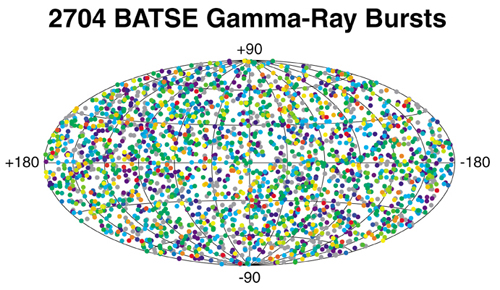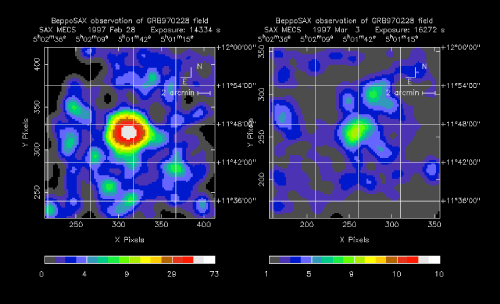Then vs. Now:
Gamma Ray Bursts
For nearly 30 years, gamma-ray bursts had astronomers utterly stymied. These bursts are the biggest explosions known in the universe. But, they are random and fleeting, releasing more energy than a billion suns in just a few seconds.
When Imagine the Universe! debuted ten years ago, scientists had little clue about what caused the bursts. They didn't know how much energy the bursts emitted, and they didn't know whether they were close (in our own Galaxy) or far away in other galaxies. Today we know that they signal the birth of a black hole in distant galaxies.
Gamma-ray bursts were discovered in the late 1960s. U.S. satellites were monitoring the skies for signs of Soviet nuclear weapon testing, which would release gamma rays. It soon became clear to scientists that the frequent flashes of gamma rays were not coming from below (nuclear testing on Earth) but rather from above (natural activity in the cosmos). In subsequent years, astronomers piggy-backed gamma-ray burst detectors on a number of satellites and interplanetary probes. With these detectors spread across our solar system, astronomers created the Interplanetary Network. Individual detectors could not tell from what direction a burst came. But scientists could determine the approximate location in the sky of a gamma-ray burst that lit up any three detectors, through a process called triangulation.
The flashes were so random and brief, however, that two full decades passed before any real progress could be made in studying them. In 1991 NASA launched the Compton Gamma Ray Observatory. This satellite contained an instrument called BATSE that monitored much of the sky for gamma-ray burst activity. BATSE could determine the position of a burst within a few degrees.
Despite all the measurements, the problem was that each burst looked different. At a science meeting in the mid-1990s, Dr. Bill Paciesas, a member of the BATSE team, famously quipped, "If you've seen one gamma-ray burst, you've seen one gamma-ray burst." At one point there were over 100 theories to explain what they were, almost the same number as detected gamma-ray bursts, scientists joked.
The Debate
Astronomers wanted to determine how much energy the bursts emitted. Knowing this would give them a clue as to what type of phenomenon might cause it. Was it something happening on the surface of a neutron star, or was it a stellar explosion?
But knowing the energy required knowing the distance to the burst. But the bursts were just too fast to measure their distance.
In April 1995 a public "Great Debate" was held---for both fun and for serious science---about how far away the gamma-ray bursts originated. Are they local or cosmological? That is, are they in or close to our galaxy or billions of light-years away, from the early universe? By this time, BATSE had detected over 1,000 bursts. The BATSE map showed bursts distributed evenly across all parts of the sky.

The debaters were two well-respected theorists who are still at the top of their field today: Bohdan Paczynski of Princeton University, and Donald Lamb of the University of Chicago. Paczynski thought that the bursts were cosmological; Lamb held the argument that they were closer.
Paczynski based his argument largely on the burst distribution. The bursts appeared everywhere, just like galaxies, as opposed to explosions in the Milky Way galaxy, which appear to us along the galactic plane. Lamb suggested that high-velocity neutron stars shooting out of the galactic plane could explain some bursts. But as Lamb eloquently stated during the debate, sufficient observational evidence was lacking for either argument and that "those who study gamma-ray bursts have only the laws of physics and the properties of the bursts themselves to guide them."
The Breakthrough
The major breakthrough came on February 28, 1997. An Italian-Dutch satellite called Beppo-SAX discovered an X-ray afterglow of a gamma-ray burst. While the burst fades in seconds, the afterglow can linger for days. Studying the afterglow allows scientists to piece together what caused the burst, similar to how a detective hunts for clues at a crime scene.

Now scientists had proof that afterglows existed and that it was important to look as quickly as possible.
The Beppo-SAX afterglow detection was from GRB 970228, a burst named after the date it was discovered. The ground-based William Herschel Telescope and the orbiting Hubble telescope were able to image GRB 970228. It was indeed located in another galaxy, very far away. One mystery solved: Most bursts are cosmological. But what are these things?
Satellites to Solve the Mystery
With the Beppo-SAX discovery, scientists realized they needed a dedicated gamma-ray burst mission to pin down burst locations in order to find the afterglows. The sky is huge. Unless they know exactly where the burst came from, scientists can't be sure whether they are studying the afterglow or the light from some other cosmic phenomenon. Also, the first hours of the afterglow hold crucial information.
The first such mission was HETE, built largely by MIT and launched in 2000. In 2003, HETE, a small and inexpensive mission, determined that longer bursts, lasting over two seconds, were from distant and massive star explosions. The gamma rays form when the core of the star implodes to create a black hole.
Next came a more powerful, international, NASA-led mission called Swift, launched in 2004. Swift has on-board X-ray and ultraviolet/optical telescopes that have revolutionized the study of gamma-ray bursts. Swift provides speed and precision.
Swift detects bursts and turns its instruments towards the bursts within seconds. Swift also relays the burst location to scientists and robotic telescopes worldwide via the Gamma-ray Burst Coordinates Network, created at NASA Goddard by Scott Barthelmy. As a result, major observatories---such as Hubble and the giant, ground-based Keck and Gemini telescopes, to name only a few---have captured burst afterglows in amazing detail.
What We Know Now
There are two types of gamma-ray bursts, characterized by their duration. In 2003, astronomers using HETE verified that the longer bursts (lasting more than two seconds) arise from the core collapse of a massive star, and result in a black hole. A nearby, bright burst, GRB 030329, provided the "Rosetta Stone" for the connection between supernovae and gamma-ray bursts.
In 2005 Swift was swift enough to determine that short gamma-ray bursts, lasting under two seconds and often just a few milliseconds, are from mergers between two neutron stars or a neutron star with a black hole. In either scenario, a new black hole forms. In one short burst, scientists have evidence of an old black hole ripping apart a neutron star and swallowing the whole thing, crumbs and all, creating an even larger black hole.
And here we are today. The major mystery of their place in the universe has been solved. Astronomers are still sorting out the exact mechanism to explain the details of the observations. But Swift and Swift-prompted follow-up observations promise to reveal the intricacies how black holes are forming.
While major questions remain about the physics of gamma-ray bursts, it is clear that the golden age of discovery was from 1997 to 2006. And Imagine the Universe! was along for the ride.
10th Anniversary Articles
Additional Links
As part of the series, we also published a number of retrospectives on Imagine the Universe!
Publication Date: April 2006


